A Revolution
Words: Dan Kamys
Blades
By Brett Martin
[caption id="attachment_10142" align="alignright" width="300"]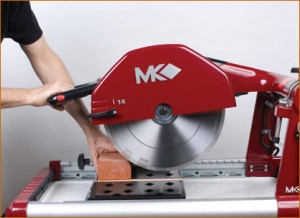 Image Courtesy of MK Diamond Products, Inc.[/caption]
Image Courtesy of MK Diamond Products, Inc.[/caption]
Masonry contractors who are still buying run-of-the-mill diamond blades may not realize there's a revolution going on in blade technology. Better diamond placement means blades are able to cut faster through a greater variety of materials and last longer. And, consider this: The blades cost less money per cut and can improve productivity.
Brian Delahaut, VP and general manager for MK Diamond Products Inc. in Torrance, Calif., predicts that diamond blades will gradually become less specialized and more generally purposed, a trend that's already started.
"What's happening in the industry is, the diamond quality is continuing to improve," Delahaut says. "The crystals are much more sophisticated and consistent in shape and size. Many blades today are reaching a cutting efficiency that lets them cut a wider variety of materials."
Faster cuts, longer life
Blades with diamonds placed in specific locations enhance cutting and prolong the blade's life.
[caption id="attachment_10144" align="alignleft" width="188"]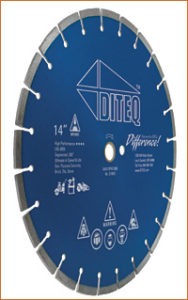 Diteq_ARIX blade Image Courtesy of Diteq Diamond Tools and Equipment[/caption]
The ARIX blade from DITEQ Diamond Tools & Equipment in Lee's Summit, Mo., uses a Diamond Arrangement Technology System to strategically place the diamonds for maximum performance, says Dan Steiner, company president.
Diteq_ARIX blade Image Courtesy of Diteq Diamond Tools and Equipment[/caption]
The ARIX blade from DITEQ Diamond Tools & Equipment in Lee's Summit, Mo., uses a Diamond Arrangement Technology System to strategically place the diamonds for maximum performance, says Dan Steiner, company president.
Previously, blades were made softer to cut faster, which meant they wore down quicker. Or, they were made harder to last longer, but then cut slower.
"People used to think that you had to sacrifice cutting speed to get longer life, and vice versa, but ARIX gives you both," Steiner says. "The product is truly amazing. It cuts faster and lasts longer. It changes everything."
Steiner says ARIX blades cut 50 percent faster and last 30 percent longer.
"This blade puts the diamonds in a row for uniform wear," he says. "When one diamond wears out, a new one takes its place."
[caption id="attachment_10143" align="alignright" width="150"]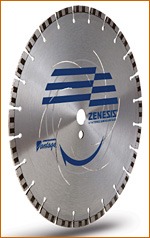 Diamond Vantage_Zenesis Silent Core Image Courtesy of Diamond Vantage[/caption]
The new Zenesis blades from Grandview, Mo.-based Diamond Vantage Inc. offer consistent diamond exposure for more efficient cutting, says Graeme Gilmour, president and CEO.
Diamond Vantage_Zenesis Silent Core Image Courtesy of Diamond Vantage[/caption]
The new Zenesis blades from Grandview, Mo.-based Diamond Vantage Inc. offer consistent diamond exposure for more efficient cutting, says Graeme Gilmour, president and CEO.
"The blade is patented technology that specifically locates diamonds where optimum cutting performance can be achieved," Gilmour says. "It cuts quicker because of equal exposure of the diamonds, and none of the diamonds will fall out of the segment until it's completely used, extending the life of the blade."
Gilmour says the blades cut 30 percent to 60 percent faster and offer 20 percent to 40 percent more blade life.
Although technologically advanced blades cost more than standard blades, masonry contractors get more cuts per blade, which offsets the cost.
"In terms of cost per cut, you're getting the best price on the market," Steiner says.
[caption id="attachment_10145" align="alignleft" width="300"] MK Diamond_DMX Image Courtesy of MK Diamond Products, Inc.[/caption]
MK Diamond_DMX Image Courtesy of MK Diamond Products, Inc.[/caption]
Cut quicker through more
Some new masonry blades cut faster through a greater variety of materials. The MK-762 DMX (Diamond Matrix) Supreme blade from MK Diamond Products uses an "arrayed pattern" of diamonds to cut a broad range of materials with maximum performance, Delahaut says.
"It's designed to give the contractor the ability to cut materials at an extremely fast speed, which helps to reduce operator fatigue," he says, adding that the blade is slightly more expensive than blades that have diamonds randomly placed, but contractors realize the benefit with the increased cutting speed.
"What we have is 65 percent more efficiency in speed and cutting capability," Delahaut says. "If you're paying someone $20 an hour, and he's cutting 100 bricks per hour, you can increase the number of cuts per hour by 65 percent. From a contractor's standpoint, it's going to save you money."
[caption id="attachment_10146" align="alignright" width="275"]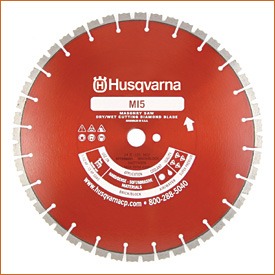 Husqvarna_MI5 Image Courtesy of Husqvarna Construction Products North America[/caption]
John Siva, director of diamond research and development for Olathe, Kan.-based Husqvarna Construction Products North America, says his company plans to release the Diagrip blade in America within the next two years. Diagrip, currently available in Europe, is designed to cut all types of materials, even reinforced concrete.
Husqvarna_MI5 Image Courtesy of Husqvarna Construction Products North America[/caption]
John Siva, director of diamond research and development for Olathe, Kan.-based Husqvarna Construction Products North America, says his company plans to release the Diagrip blade in America within the next two years. Diagrip, currently available in Europe, is designed to cut all types of materials, even reinforced concrete.
"This is for the contractor who values speed," Siva says. "It gives 20 to 30 percent more speed, with 10 to 20 percent more life, but I recommend it for the speed."
Husqvarna currently offers the MI5, a general-purpose blade that has a specific diamond segment for faster cutting.
Highly versatile, generally purposed
Newly designed general-purpose blades can cut almost any material without wrecking the blade. Precision Diamond Tools Inc. in Palm Beach Gardens, Fla., recently hit the market with the Alpha Ape, Sonic Red and Super Sonic GP blades, which have the correct bond to cut soft, medium and hard materials, says Jason Hunkler, company president.
"We have a diamond blade that is an all-combination blade that will cut anything," Hunkler says. "Masonry contractors tend to cut a lot of different materials. This saves them a lot of time. They don't have to switch blades. Anybody can grab it and cut with it."
[caption id="attachment_10147" align="alignleft" width="300"]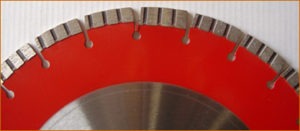 Precision Diamond_Alpha Ape[/caption]
Precision Diamond_Alpha Ape[/caption]
Hunkler says since the blades can cut a variety of materials without getting damaged, contractors won't have to buy as many blades. "It isn't a cheap solution. It's a long-term solution that will save money and time in the long run."
Diamond Vantage has a new multipurpose blade, AllCut, that can cut masonry, steel, stone and concrete, among other things, Gilmour says.
[caption id="attachment_10148" align="alignright" width="190"]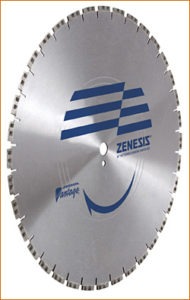 Diamond Vantage_Silent High Speed Zenesis Image Courtesy of Diamond Vantage[/caption]
Diamond Vantage_Silent High Speed Zenesis Image Courtesy of Diamond Vantage[/caption]
"It will cut through rebar and wood quickly," he says. "You can keep the blade on the jobsite to cut limestone, and then cut rebar."
Delahaut expects that general-purpose blades will become the norm over the next decade.
"If I look out over the next 10 years, I think we'll end up with only few blades that will be able to cut nearly every masonry and stone material found on most jobsites," he says. "Most of the specialized blades today will evolve into a general-purpose blade. This will give so much more versatility to the contractor."
Reduced noise
Masonry blades tend to leave a high-pitched ringing in the user's ears. Manufacturers have responded with blades to reduce that noise, resulting in a quieter, safer work environment.
"We carved out pieces of the steel core and filled them an epoxy resin," Gilmour says of the Silent High Speed Zenesis blade. "That deadens the sound and makes it quiet."
[caption id="attachment_10149" align="alignleft" width="300"]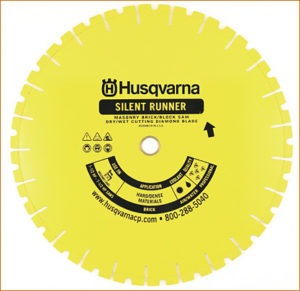 Husqvarna_Silent Runner Image Courtesy of Husqvarna Construction Products North America[/caption]
Husqvarna offers Silent Runner blades, available in five grades of hardness, including the new S10 blade for general-purpose block and soft brick, that produce less noise, Siva says.
Husqvarna_Silent Runner Image Courtesy of Husqvarna Construction Products North America[/caption]
Husqvarna offers Silent Runner blades, available in five grades of hardness, including the new S10 blade for general-purpose block and soft brick, that produce less noise, Siva says.
"These blades have a sandwiched steel core, so the core itself has three layers that absorb the harmonics," he says. "It prevents vibrations in the steel core, which is the best way to reduce noise."
Steiner says DITEQ is planning to unveil a new silent core blade later this year. "Products that cut more quietly are going to be the future," he says. "It may revolutionize masonry saws in high-traffic areas like schools, hospitals and shopping centers."
Brett Martin is a Minneapolis-based freelance writer with 15 years of construction and writing experience.
Return to Table of Contents